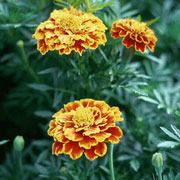


Home
Flowers &
Indoor Plants
Fruits & Nuts
Ornamentals
Vegetables
Special Topics
Resources
Glossary

|
American Marigold Tagetes erecta (tah-get-eez ee-rec-tah) Click on thumbnails for larger image. |
 |
What about it? American Marigold is a member of the Compositae Family, and therefore related to the daisy. Marigolds have oil glands in their leaves that release a distinctive odor when crushed. This odor also repels insects which makes Marigold a popular garden plant. The American Marigold grows up to 36" and has large (2-4) solitary heads of orange or yellow. What is it used for? American Marigold has a long blooming period that makes it one of the most popular annuals. It is often used in nursery plantings to control nematodes, or in gardens for companion planting strategies to repel insects. Odorless varieties are available though and Marigolds are seen as cut flowers, in bedding, or as a border plant. Where does it grow? How do we grow it? Marigold enjoys moist, fertile, well-drained soil and a spot in the full sun. They should be spaced 12" apart. Remember to remove the old flower heads. What are its primary problems? The American Marigold is prone to botrytis blight, leaf spot, wilt and stem rot, spider mites, and Japanese beetles. How do we propagate it? Seeds should be sown indoors 4-6 weeks before the last frost or outside after the last frost.
© Copyright, Department of Horticulture, Cornell University. |